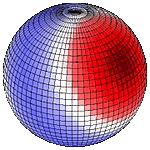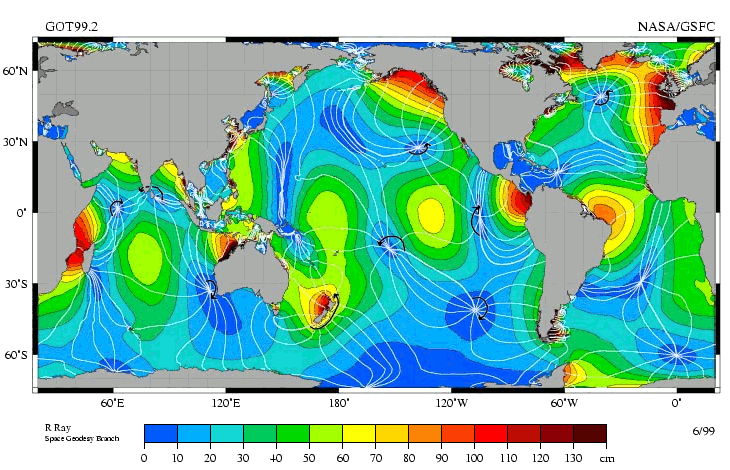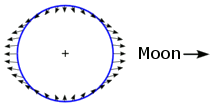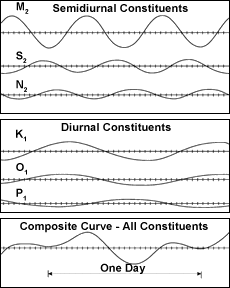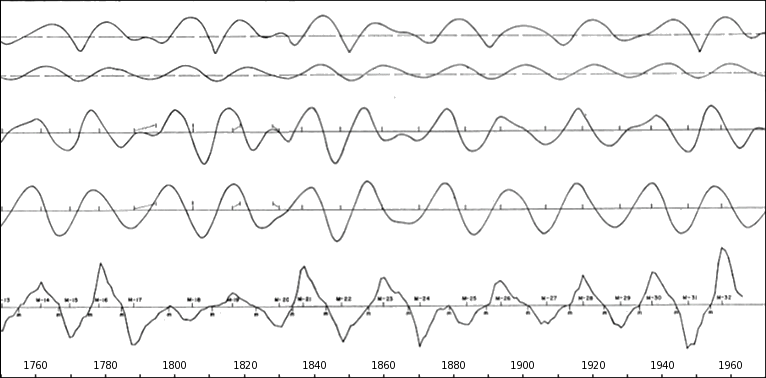© Charles ChandlerFor a planet with a crust that has been solid for at least a couple million years (if not longer than that), the Earth is surprisingly dynamic. Earthquakes, volcanoes, and tectonic plate motion are driven by one or more unknown energy sources. A full accounting of the forces that keep churning inside the Earth remains outside our reach, but everyone is in agreement that tidal deformation is one of them, and both earthquakes and volcanoes are more likely when tidal forces are at their maximum. Yet there are some big gaps in our understanding of tides.
1) the distance from center of solar system mass to center of Sun,
2) the radius of curvature of Sun's path,
3) the rate of change in the angular momentum about the center of mass,
4) the rate of change in the angular momentum about the center of curvature, and
5) number of sunspots (up is one magnetic polarity and down is the other)Note that the forcing mechanism is on a 22-year cycle, while sunspots peak every 11 years. This suggests that some sort of internal oscillation causes the 11-year cycle, while every 22 years another set of forces comes into play, synchronizing the two cycles.11 This stands up to reviews of long-term data.The system becomes fully non-linear when we consider that proton storms from CMEs can modulate tidal forces here on Earth.12 And those forces can, in turn, trigger volcanic eruptions and earthquakes.12 But note that the present thesis suggests a different interpretation of the relationship. In a later section, volcanoes are described as electrical conduits, wherein the magma is kept molten by ohmic heating from a current flowing between the Moho and the surface. Accentuated crustal tides are thought to encourage the magma, by kneading the crust, but in the present model, the relationship is the other way around — the conductivity of the magma tube allows charge imbalances in the Moho to be satisfied locally, leaving less need to pull electrons from the far side, and thereby partially decoupling the antipodal tide. Thus the crust near the volcano flexes more freely. If this is correct, any accentuation in crustal tides near a volcano will be accompanied by a corresponding attenuation in the antipodal bulge, proving the coupling.
1. Thompson, L. (2014): Equilibrium Tides. washington.edu ⇧
2. Chandler, C. (2019): CFDLs Caused by EDP. QDL, 12483 ⇧
3. Denham, L. et al. (2013): Dynamic Measurement Case Histories. Dynamic Measurement LLC ⇧
4. Grunskaya, L. V.; Morozov, V. N.; Efimov, V. A.; Zakirov, A. A. (2010): Lunar tides in the electric field of the atmospheric boundary layer. Russian Physics Journal, 53 (1): 23-28 ⇧
5. Hongchun, Z. (1983): Coupling influence of atmospheric tidal oscillation on atmospheric electric property. Science China (Mathematics), 28 (7): 752-763 ⇧
6. Jose, P. D. (1965): Sun's Motion and Sunspots. The Astronomical Journal, 70 (3): 193-200 ⇧
7. Condon, J. J.; Schmidt, R. R. (1975): Planetary tides and sunspot cycles. Solar Physics, 42 (2): 529-532 ⇧
8. Landscheidt, T. (1999): Extrema in Sunspot Cycle Linked to Sun's Motion. Solar Physics, 189 (2): 413-424 ⇧
9. Wilson, I. (2014): Resynchronisation of the solar cycle with Jupiter-Earth-Venus tides. ⇧
10. Scafetta, N.; Willson, R. C. (2013): Empirical evidences for a planetary modulation of total solar irradiance and the TSI signature of the 1.09-year Earth-Jupiter conjunction cycle. arXiv, astro-ph.SR ⇧
11. Wilson, I. R.; Carter, B. D.; Waite, I. A. (2008): Does a Spin–Orbit Coupling Between the Sun and the Jovian Planets Govern the Solar Cycle? Publications of the Astronomical Society of Australia, 25 (2): 85-93 ⇧
12. Corbyn, P. R. (2014): The Solar-Lunar-Action-Technique (SLAT) for predicting weather, earthquakes, etc. ⇧ ⇧











